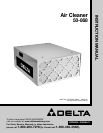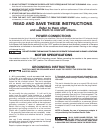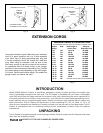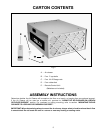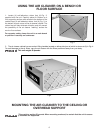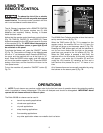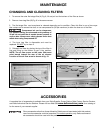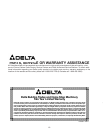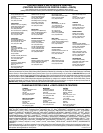
3
13. DO NOT ATTEMPT TO REMOVE OR REPLACE THE FILTER(S) WHILE THE UNIT IS RUNNING. Make certain
that the unit is disconnected from the power source.
14. MAINTAIN THE UNIT IN TOP CONDITION. Keep filters clean for optimum performance. Follow all instructions for
changing and cleaning filters.
15. STORE THIS UNIT IN A LOCATION that eliminates the potential of damage to the power cord. Safely store power
cord on the unit to eliminate tripping hazards.
16. TURN THE UNIT “OFF” AND DISCONNECT IT FROM THE POWER SOURCE before installing or removing
accessories, or when making repairs.
READ AND SAVE THESE INSTRUCTIONS.
Refer to them often
and use them to instruct others
.
GROUNDING INSTRUCTIONS
THIS TOOL MUST BE GROUNDED WHILE IN USE TO PROTECT THE OPERATOR FROM
ELECTRIC SHOCK.
2. Grounded, cord-connected tools intended for use
on a supply circuit having a nominal rating less than
150 volts:
This tool is intended for use on a normal 120-volt circuit
and has a grounded plug that looks like the plug illustrat-
ed in Fig. A.
If a properly grounded outlet is not available, a temporary
adapter, shown in Fig. B, may be used for connecting the
3-prong grounding type plug to a 2-hole receptacle. The
temporary adapter should be used only until a properly
grounded outlet can be installed by a qualified electrician.
The green colored rigid ear, lug, or the like extending from
the adapter must be connected to a permanent ground
such as a properly grounded outlet box cover. Whenever
the adapter is used, it must be held in place with a metal
screw.
NOTE: In Canada, the use of a temporary adapter is
not permitted by the Canadian Electric Code.
IN ALL CASES, MAKE CERTAIN THE
RECEPTACLE IN QUESTION IS
PROPERLY GROUNDED. IF YOU ARE NOT SURE, HAVE
A QUALIFIED ELECTRICIAN CHECK THE RECEPTACLE.
1. All grounded, cord-connected tools:
In the event of a malfunction or breakdown, grounding
provides a path of least resistance for electric current to
reduce the risk of electric shock. This tool is equipped
with an electric cord having an equipment-grounding
conductor and a grounding plug. The plug must be
plugged into a matching outlet that is properly installed
and grounded in accordance with all local codes and ordi-
nances.
Do not modify the plug provided - if it will not fit the
outlet, have the proper outlet installed by a qualified
electrician.Improper connection of the equipment-
grounding conductor can result in risk of electric shock.
The conductor with insulation having an outer surface that
is green with or without yellow stripes is the equipment-
grounding conductor. If repair or replacement of the
electric cord or plug is necessary, do not connect the
equipment-grounding conductor to a live terminal.
Check with a qualified electrician or service personnel
if the grounding instructions are not completely under-
stood, or if in doubt as to whether the tool is properly
grounded.
Use only 3-wire extension cords that have 3-prong
grounding type plugs and 3-hole receptacles that accept
the tool’s plug, as shown in Fig. A.
Repair or replace damaged or worn cord immediately.
POWER CONNECTIONS
A separate electrical circuit should be used for your machines. This circuit should not be less than #12 wire and should
be protected with a 20 Amp time lag fuse. If an extension cord is used, use only 3-wire extension cords which have 3-
prong grounding type plugs and matching receptacle which will accept the machine’s plug. Before connecting the unit
to the power line, make sure the switch (s) is in the “OFF” position and be sure that the electric current is of the same
characteristics as indicated on the machine. All line connections should make good contact. Running on low voltage
will damage the unit.
DO NOT EXPOSE THE MACHINE TO RAIN OR OPERATE THE MACHINE IN DAMP LOCATIONS.
MOTOR SPECIFICATIONS
Your machine is wired for 120 volt, 60 HZ alternating current. Before connecting the machine to the power source,
make sure the switch is in the “OFF” position. The full-load current is 5.0 amps.



